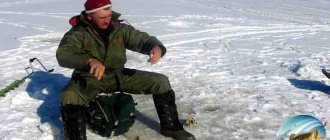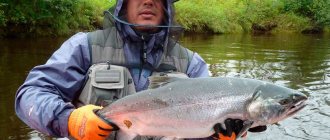Squeak is not a name, but rather the nickname of a small striped fish that lives in silted, overgrown, swampy rivers and lakes, planters, ditches and holes. Of course, this fish has a name – loach. Like crucian carp, the squeaker is probably familiar to almost everyone, and there are few people who will shrug their shoulders in bewilderment at the mention of this name.
And yet, let me introduce: a loach. An elegant small head with dark beady eyes and five pairs of antennae (two pairs each on the upper and lower jaws, 1 pair in the corners of the mouth), a long cylindrical body, three longitudinal dark stripes on the side - agree, it is difficult to confuse him with anyone .
It’s not for nothing that they call him a squeaker: a captured loach, squirming and trying to escape, emits a desperate squeak. Of course, he has no vocal cords, he squeaks... how can I say this... in general, the sound owes its origin to the exit of air through the anus. This is how the nickname stuck to the fish - squeak, gudgeon, so gudgeon and gudgeon are “two big differences.”
It’s very difficult to hold a loach in your hands - it seeps out, flows out even through tightly clenched fingers and leaves - if you don’t put a bucket or bag in time - into the wild. This fish is mistakenly considered naked; in fact, it has scales, only very small ones.
Loaches can “predict the weather”: before a thunderstorm they often rise to the surface: they rush in shallow water, stirring up the water - this means prolonged bad weather. It is not for nothing that in Germany the squeaker is called Wetterfisch (Wetter - weather, Fisch - fish, barometer fish). Of course, the loach does not have the gift of clairvoyance; simply by receptors located in the skin, he acutely senses changes in atmospheric pressure.
Another interesting point: in the process of breathing in a fish, not only the gills are involved, but also... the intestines! More precisely, its posterior section, densely intertwined with blood vessels, does not take part in the digestion of food. The fish rises to the surface, swallows air bubbles and “rolls” them through the intestines. The air gives up its oxygen, saturating the blood in the capillaries with it.
Evolution “gave” this wonderful adaptation to the loach for a reason, thanks to an additional method of breathing, but it can tolerate not only a deficiency, but also an almost complete absence of life-giving gas in the water and survives where even crucian carp cannot survive!
If the reservoir is dry, the fish fall into a kind of summer hibernation, burying themselves in wet silt; can live for quite a long time in puddles of liquid mud left in the place of a pond or ditch that dried up in summer. I once had the opportunity to rescue two three-liter jars of small (up to 5 cm) bindweed from a small mud puddle with an area of no more than 1 m2 - the puddle was simply teeming with them. Moreover, there was about 1.5 cm of water in the hole, the rest was taken up by dirt.
“I caught a huge loach - it barely fit into the frying pan.” I do not know. The heaviest thing you can catch here weighs 100 grams and 25 centimeters in length. Well, sometimes a little more than 30cm. And that's it, the limit.
The lazy loach does not like to travel, unless the flood takes him somewhere far from home. Spawns in the spring, in April-May, mainly during floods, so that the water carries the offspring away from the habitats of the parents. This small fish has fairly large caviar – almost 2mm in diameter. The larvae also develop additional respiratory organs: a powerful network of blood vessels, first on the surface of the yolk sac, then in the pectoral fins and temporary thread-like structures called external gills.
You can catch loach almost all day long, but it still catches better in the morning and evening hours. This fish is not particularly careful, so it allows you to get close to it, and there is no need for long casts. A light fly rod 4-5m long is suitable. The float is relatively light, with a load capacity of about 0.5-1g. Small hooks No. 13-14 (international).
The best bait for the loach is bloodworms; it is its main natural food. But this fish also responds well to pieces of worms, small maggots, and caddis flies. It is advisable to load the bait so that the bait lightly touches the bottom, or is 1-2cm from the bottom. Often found mixed with crucian carp. As a live bait, the loach has been highly appreciated by fishermen - in many regions it is the No. 1 bait fish.
By the way, a cute striped fish with soft touching antennae can be safely planted in an aquarium - the loach will not offend its pampered decorative inhabitants.
lovimvse.ru
Note on catching loaches
If a fish lives in an aquarium or some other container, it begins to get very worried, tries to get out countless times within a minute, and does not accept any food. Fishermen say that then it’s not worth going fishing, no fish will bite.
If the loach is actively feeding and behaving normally, then you can go fishing.
Catching loaches with a float rod
To catch a loach on a float rod, use a small float and a thin line. The hooks are tied small, the sinkers are adjusted so that the bait almost lies on the bottom, and the line sags very little.
The loach is found where there may be solid hooks, and the loach itself, greedily and confidently grabbing the bait, will quickly break free.
The hook should not be done right away. Although the loach almost never gets off the hook, you need to wait for a few exercises with the float: it will tremble a little, go under the water, and jump left and right.
It is better to catch loaches at sunset before nightfall. A worm is suitable as a bait; there have been cases when a loach grabbed an empty hook.
It is almost impossible to hold the loach, how slippery it is, and getting it onto a hook as bait is also a problem. The loach is readily taken by predatory fish, such as pike. Read also: catching pike with a girder.
After catching a loach, you need to place it in the water. This fish is very tenacious and can be preserved for a long time for various purposes.
Loach meat can be eaten in any form. It is very tender, tasty, similar to tench meat, and also does not have small bones.
Catching loaches in winter
When catching loaches in winter, you must first clear the area of vegetation and silt.
Catching a loach with a basket
It would be more correct if you catch loaches in spring or summer. There is an interesting method called “trampling loaches.” It consists of placing a basket in the center, overgrown with vegetation. The fish are driven out of their shelter in the mud and driven into a basket, that is, they are trampled down in a peculiar way.
People respect the loach for its endurance and overcoming life's adversities; it is not without reason that it has long been included in Russian folklore through proverbs and sayings.
Catching loach with traps in summer and winter
The loach is not particularly popular among many fishermen. This is due to its not very pleasant snake-like appearance (resembles an eel) and the places where this fish prefers to live (silted lakes, bolts, creeks with dense vegetation).
Nevertheless, this is a very tasty and interesting fish, and its catch is completely justified. This fish causes enormous damage to other species of fish by eating the eggs they lay, sometimes the loach can thus devastate entire bodies of water. Therefore, catching loaches in any season is necessary.
Most often, the loach can be found in a reservoir with a silted bottom. In length, this fish can reach 30-35 cm, has a serpentine body shape, the ventral and dorsal fins are moved back. The caudal fin has a rounded, convex blade. The body of the loach is covered with black or light brown spots, and there may also be light and dark stripes. The diet of this fish includes a wide variety of food, insect larvae, earthworms, eggs of various types of fish and small shellfish.
The same insect larvae, worms and shellfish meat can be used as bait for catching loaches. Peak loach activity occurs at night. You can catch this fish with a float rod, just like everyone’s favorite crucian carp from the bottom. The tackle is equipped with a fishing line of 0.14-0.17 mm, the color of the fishing line must match the color of the bottom or water of the given reservoir.
In addition, when catching loaches in the summer, they also use traps, the so-called “kosh”, which are woven from willow twigs. You can catch this fish with a “mouth” or, in other words, a “top”. Such traps are usually woven from wire or silk thread. They are installed in small creeks, creeks, and channels between reservoirs. If the place is chosen well, then with one such trap you can catch several kilograms of loach per night.
Now let's talk about winter loach fishing. And although few fishermen engage in such fishing, it is very interesting, and the meat of the loach is tasty, which means it is well worth doing it. However, trying to catch a loach with a regular winter fishing rod from the ice is not worth it; this is an almost useless activity, unlike summer fishing. Winter loach fishing is carried out using traps and this is the only way to count on a good catch. With one trap in winter it is quite possible to catch several dozen specimens of this fish in one fishing trip.
Winter traps are different from summer loach traps. Making such a trap is not at all difficult. A rim from a sieve, which every housewife has, is quite suitable for this; you can also take an unnecessary basket, an old box or box. That is, a container that has hard sides.
A bottom is made of tarpaulin for the future trap, in which a hole is made in the middle. A piece of hose or tube with a diameter slightly larger than the diameter of the loach’s body is threaded into this bottom. It should also be taken into account that the tarpaulin should be slightly raised, so that there is a distance of about 5 centimeters from the edge of the sieve to the tube. Our loach trap is almost ready. In order to have a good catch of loach, you must first drill a small hole. Such a hole is needed in order to collect as many fish as possible at the fishing site, which tend to the oxygen-rich place formed as a result of the appearance of the hole.
First, you need to make the size of the hole smaller in diameter than the size of the trap itself. As a rule, such an ice hole is covered from above with tree branches or dry grass; it is possible to use tree bark and snow. This is done to avoid freezing of the hole.
Next, winter loach fishing enters a waiting phase. This is done so that as much loach as possible accumulates in the hole area and it is better to wait 2-3 days. It is easy to determine that the loach is interested in the “oxygen bait”. Foam appears on the surface of the water in the ice hole. This is the main sign that there are a lot of fish in this place on the bottom.
If the reservoir is small, then you can usually determine the presence of a loach by the squeak that this fish makes when swallowing air. The most interesting thing is that during the process of respiration, the main part of oxygen enters the loach’s body through the skin and only a smaller part through the gills.
Having determined that a large number of loaches are concentrated at the bottom under the ice, the hole, as a rule, expands. When the hole reaches the desired diameter and fits the trap, it must be installed correctly. Experienced fishermen recommend setting the trap so that it is completely out of the water. Otherwise, the loach will not stay in the trap for long and will soon leave it. To make loach fishing successful, it is recommended to cover the hole again with dry hay, branches or spruce branches.
Catching loaches in winter using the traps described above is the main type of catch during this period. As for the gastronomic qualities of eel, they are worthy of the highest praise. Loach can be fried in a frying pan, baked over coals, or stewed. Especially the meat of this fish, like eel, is delicious when smoked. And the loach has significantly fewer bones than the same crucian carp.
In addition, such a wonderful fish as loach, in addition to tasty and nutritious meat, has a very useful property for fishermen. Since ancient times, people have been able to accurately predict the weather based on the behavior of loaches.
If the loach behaves calmly, this means that in the near future the weather will be good and stable. If the loach begins to rush and circle near the very surface of the water, worsening weather with heavy precipitation is expected. This means that you can safely go fishing for perch or pike, because the bite of these fish in bad weather, on the contrary, becomes more active.
Among other things, loach is an excellent bait. Moreover, loaches are distinguished by their vitality and remain mobile for a long time, even when on a hook as bait, which means that it is always beneficial to have such live bait with you.
However, in this case the t0 of water must be taken into account. If temperature changes occur, the loach begins to behave strangely by fish standards, and the predator you are hunting for can be very alarmed by this, which means that the loach is not a suitable choice as a live bait during such periods.
A good catch of loach in winter largely depends on the correct location and installation of the trap. If everything is done correctly, then you can catch several dozen, and sometimes hundreds of individuals with one trap.
fishers.spb.ru
Method of catching loach fish
The loach is taken with any bait; in a very stormy bite it is enough even for a bare hook. At sunset the bite is always more active. At night, he also does not sleep and pecks. The loach has a special bite: when the float floats with the current, it is at first slightly submerged, as if it is catching on the bottom, but then it abruptly goes under the water and here you have to not yawn. You need to hook after several such drownings. The loach’s appetite, frankly speaking, is excellent; as I already said, it grabs greedily and there are almost no empty bites.
Instead of a hook, they tie a needle, not behind the ear, but in the middle, and attach a worm or bloodworm. When you hook a loach, the needle becomes straight across and you can’t get off such a tackle. Previously, wicker baskets lowered into an ice hole were used as artificial traps; today they are successfully replaced by various network traps: - Muzzles, tops, hems.
Winter fishing for loach
In winter, fish in reservoirs do not have enough oxygen and fishermen go out fishing to help supply it to the reservoir. How? It’s simple, each fisherman drills more than one hole during one fishing trip, and taking into account how many fishermen go out on the ice, the figure turns out to be quite impressive. So the fisherman not only catches fish, but also contributes to its survival in winter by drilling holes to enrich the water with oxygen. In winter and summer, loaches are caught using specially made traps.
In our language they are now called muzzles: they are a box woven from wire or wicker with a bottom that opens at the bottom.
And the neck should fall inside the box so that the fish, when leaving it, bumps into the walls. You can also cover the entrance with a tarpaulin, and insert a tube into it through which the loach could get there. This method of fishing gives good results and a fairly large catch.
In summer, such a muzzle is simply thrown into the right place, and in winter special holes are made. The hole is widened with an ice pick, having previously been drilled with a drill, then it is covered with straw or twigs so that it does not freeze. Then we will have to wait two or three days for the loaches to gather near this place and begin to enter our face. The loach, out of necessity, will enter the trap to grab air, but will no longer be able to leave due to the structure of the trap. Thus, by checking the muzzle every day, you can simply collect a rich catch. The taste of loach fish is not bad and it can be prepared in different ways. Boil or fry the fish soup, you can dry it and then drink it with beer instead of seeds, which is also good.
At the end of it all, we need to remember that the loach fish fed entire families in the recent past.
Due to its vitality and great fertility, there were very large quantities of it in rivers and streams, in many ponds. It easily coexisted with other types of fish in the same territory and was good food for predatory fish.
The fishermen were happy to catch her, until for some reason she disappeared somewhere. Nowadays, loaches are found, but much less frequently than in the recent past.
pescare.ru
Trap basket
Winter fishing is somewhat different from fishing in warm seasons. You will need to make your own trap for this. A basket, sieve, box or any similar container will do. A tarpaulin is placed on the bottom, and a hole is made in the center of the trap, which should be slightly higher. The principle of a crayfish trap is used, where there is an opportunity for fish to enter, but not for exit. To make such a hole, you can use several methods. Try installing a tube with a larger diameter than the thickness of the loach's body. It is desirable that it be several centimeters higher than the bottom, but at the same time lower than the sides of the trap.
Using a trap: A hole with a smaller cross-section than the diameter of the trap is cut in a reservoir. Twigs are laid on top of it, and then the whole thing is covered with hay. After everything is done, you need to wait a few days. The fish, sensing the influx of oxygen, rises up and accumulates in large schools around the hole. After several days, when a school of loaches is already near the hole, it is necessary to expand it and lower the trap there.
The sides of the trap must be higher than the water level, so the fish will not be able to get out of it. Having completed all the steps, the hole is again covered with twigs and hay. It turns out that the fish will come to the surface for oxygen and crawl into a trap from which there is no way to escape. Thanks to this method, you can catch dozens of loaches with a basket.
Appearance Features
The loach belongs to the carp family and is a freshwater fish. It grows in length from 15 to 18 cm, but there are specimens up to 30 cm or more in size. It has an elongated body, covered with very small scales, but which can be seen with the naked eye. The caudal fin has a rounded shape, and 10-12 antennae can be seen around the mouth. There is an infraorbital, non-functional spine located in the thickness of the skin. Males can be distinguished by an elongated and somewhat thickened second ray of the pectoral fin. On the left and right of the dorsal fin, there is a barely noticeable thickening formed by adipose tissue. If you have never seen this fish before, it can easily be confused with an eel or a snake.
Therefore, the loach received such a name, because of its appearance and ability to wriggle. It is possible that these factors had a direct impact on its popularity among fishermen. It is little used in food, and fishermen go out for any fish, but not for loaches.
All fins, like the rear one, have rounded, very neat shapes. The loach has both pectoral and pelvic fins, which are located at some distance from the pectoral fins. The scales of the loach are almost invisible because they are covered with a layer of mucus. On the back of an adult loach you can see black dots located on a yellow-brown surface. The belly of a loach can have different shades, depending on living conditions: it can have either a reddish or yellow color. Small, black spots can also be seen on the brown fins. The loach has small, yellow eyes.
Symmetrically, along the sides there are 3 black stripes, the middle of which is slightly longer than the other 2. Depending on the living conditions, the full color of the loach may change: if you take a loach from a river with clean running water, then the loach will have lighter colors, and if you catch this fish in a pond with a muddy bottom and not so clear water, then the loach will have shade much darker.
As mentioned above, individual specimens can reach a length of about 30 cm, and the thickness of such a fish can be equal to the thickness of an adult’s thumb.
Loach - a unique fish - fishing for loach
This fish is the least fish-like of all the others.
It rather resembles a short, thick viper. Its dark gray, sometimes yellowish, serpentine body is covered with very small scales, there are antennae on its lips, and small eyes and gill openings on its flattened head. The lowering itself indicates its ability to wriggle and slip away. “Loach” - they say about a sneaky, resourceful person.
I remember the hungry year of 1947, when I first saw this fish. The mother brought three ladle-length loaches from the market, put them in a basin, splashed water, and they began to swim and slide along the bottom, as if they had just come from the river. They reminded me then of the large leeches that used to stick to my feet at a pond bath.
And many years later I had the opportunity to be a participant in loach fishing in the same Upper Don village with an old acquaintance of mine, an avid fisherman Valentin Merkulov. It was winter, Valek unexpectedly suggested:
- Let's crush the loaches. Many people disdain them, but the fish, I tell you, is sweet.
My friend knew an old winter method of extracting loaches. We did not take any fishing rods, nets, or jigs, but only an ordinary sharp carpenter's axe. We came to an oxbow overgrown with reeds and covered with ice.
First, Valek cut down a dozen one and a half meter long willow poles, 3-4 cm thick, with young green bark. Working one at a time (my efforts were especially useful here), we cut holes in the ice, according to the number of sticks, or, as he called them, “fillers” with a diameter of 30-40 cm.
The frost was not severe, the sun was shining, and this work did not tire, but invigorated. When the last core was broken through, Valentin, using an ax, peeled and separated the bark on the poles from the thin end, tearing it off in strips so that it hung in straps. Having carried out this operation with each stick, Valek, with the soaked end, began to lower them into the holes and stick them into the bottom. The depth there was small, about a meter. Stump pegs now stuck out above the ice, around which we shoveled more snow.
The next day, as soon as the late winter morning illuminated the area, we were already at the oxbow lake. This time, a bag was added to the ax in our hands. Approaching the first peg, Valek shoveled the snow, carefully chipped the ice where it was frozen with the edge of an ax, and, saying: “God, help me!”, quickly pulled the stick out of the padding.
To my surprise, two sucking loaches were hanging on a perch among the torn bark.
“They love to eat this, what’s his name.” cambium. It’s like candy or ice cream to them,” Valek said. He hit the ice with the end of the stick. The vines fell into the snow, moved and became white with snow dust.
That day we ate loach fish soup. She was not bad, she was smart, she smelled a little like mud.
-We hurried. “They should be kept in a barrel of well water for two or three days,” he enlightened me. This smell would disappear and the ear would be like burbot.
In general, loaches bite well, wherever they are found, all summer, both day and night, on the worm. And these unpretentious fish live in stagnant swampy lakes, quiet rivers, abandoned riverbeds, and floodplains. They like shallow water, the bottom is silty and are superior to crucian carp in vitality. They can stay alive for a long time in damp moss and wet grass.
Therefore, the loach in central Russia is used by many fishermen as an excellent live bait when catching predatory fish. It is enough to put the bindweeds in a bucket with grass, splash a little water, and they will be alive all day. Pike, catfish, and eels bite well on them.
In the old days, the loach was kept in houses in an aquarium or in a jar of water as a wonderful predictor - a barometer!
Good luck with fair fishing. The given tips and notes are the experience of fishermen who wholeheartedly shared them for proper and responsible fishing... You always need to live according to your conscience and remember that we live and fish now... and our children and grandchildren will fish tomorrow!
Habitat
Most of the loach can be observed in the reservoirs of Central and East Asia. As for the European part, it is not so rich in this interesting fish. Some numbers of loaches were noticed in eastern France, as well as in the reservoirs of Yekaterinburg and the eastern Urals.
The fact that it moved to these areas indicates that the ecosystem began to be disrupted, as a result of which part of the swamps, where it is the largest representative of the ichthyofauna, dried out. Quite a lot of this fish is found in the muddy reservoirs of the Western Urals, which give rise to the largest rivers of the Asian part of Russia. Most likely, this is due to its spread closer to Asian regions.
In the Leningrad region you can hardly find loach, and only the Kronstadt Bay and Peypus can boast of the presence of this fish.
The loach prefers swampy areas and all kinds of ditches with a large amount of silt. There is quite a lot of it in the swamps of Polesie, where its fishing is widespread. It can be found in large quantities in the Kuban, but in the Crimea and the Caucasus it can hardly be found.
Nutritional Features
The loach can eat quite a variety of foods: larvae, mollusks, bloodworms, worms. It may well feed on the eggs of other fish species, which can reduce their numbers. Enjoys eating mosquito larvae.
As observations show, this representative of the underwater world is quite voracious and can cause damage to the quantitative composition of other inhabitants, such as crucian carp or carp. But this can happen if there is a lack of other food in the reservoir. If the reservoir is muddy, then the loach will find food for itself, not paying attention to the eggs of other fish species.
Video
We present you short videos on catching loaches in winter.
effective in ditches and overgrown ponds, as well as rivers with a slow flow or swampy and without a current. It is a relative of carp-like fish.
- Its scales are so small that they are not noticeable, or even completely absent.
- The eyes are small, the gills are also barely visible, there are antennae around the mouth, they look tiny, thread-like.
- The body of the loach is elongated, usually reaching two tens of centimeters, very rarely - three.
- Males differ slightly from females in fin structure: the pectoral fin is thicker and longer than that of the female. The male has a fat pad on the sides behind the fin on his back.
Loach habitats
This fish is found almost everywhere on the mainland. It prefers to live in mud, where it feeds on river mollusks, worms and larvae.
Sometimes there are no other fish in the pond where the loach lives. This is partly explained by the fact that the loach happily eats the eggs of other inhabitants and thus destroys its population.
Breeding period
Not many people know when the loach starts and when it stops spawning. Because of this, quite a few disputes arise. If you believe the observations of experienced fishermen, the loach spawns in the spring, at the beginning of March. The only problem is that the spawning period can be extended in time. Some individuals begin to spawn in winter. Females are quite fertile and can lay from 15 to 150 thousand eggs. Nature has ensured that this unique species of fish has fed humans for thousands of years.
How to catch a loach
Loach can be caught both in summer and winter. In summer, it can be caught with a regular float rod. The best option is a fishing rod with a sensitive float, equipped with hooks No. 3-No. 4. It is advisable to use a green fishing line so that it does not stand out at the bottom, among the silt and underwater thickets. The thickness of the fishing line can be within 0.25mm, although you can immediately say that it is thick enough for catching loaches, so you can use a thinner fishing line. There is no need to catch particularly large specimens. You can use grasshoppers, bloodworms, bark beetle larvae or caddis flies as bait.
According to the recommendations of experts, the bait should be cast to the border of clean water and algae, and then slowly carried out. If you have a boat, it can make the task easier. With the help of a boat you can move freely with the current. If there was a bite during the retrieve, but the fish was not caught, then you can return to the starting point and repeat your actions. There shouldn’t be any special problems with catching loaches if you have at least some skills in handling a fishing rod. At the same time, you need to have skills in handling the boat, and even more so in the current.
Loaches bite vigorously no matter when fishing occurs, day or night, although they are most active between sunset and darkness. The loach bites in a specific way: the float can sink slightly and, as it were, move to the side. The hook should be made after several such twitches. The loach's appetite is quite large, so it swallows the bait instantly and completely, so that there are practically no escapes.
Instead of a hook, you can tie a needle to the main fishing line, this is how they practice catching eels. The needle is tied not behind the eye, but in the middle. The worm is placed on a needle and thrown into the tackle. During the bite, when the loach swallows the worm with the needle, a hook is made and the needle becomes across, so that the fish has no chance to escape.











